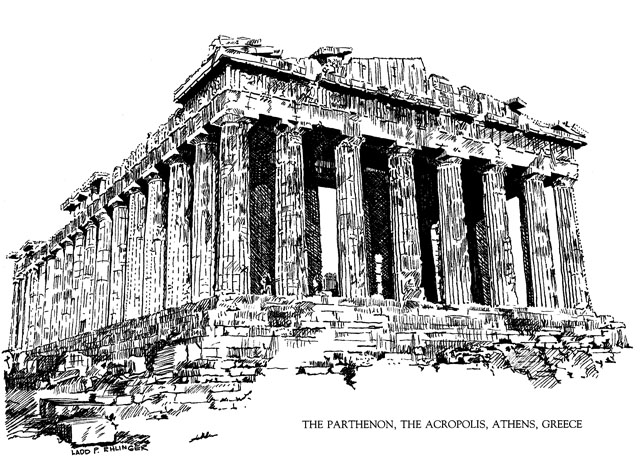
Projects Newsletters Personnel Contact

This issue’s limited edition signed print of a sketch by Ladd Ehlinger is of the Parthenon (447432 BC), which was erected on the Acropolis in Athens in the time of Pericles. This temple was dedicated to Athena Parthenos, meaning the virgin Athena. Parthenon means the virgin’s chamber, which was located in the western end of the temple as shown in the sketch, from which the building received its name.
The architects for the Parthenon were Ictinus and Callicrates, and the master sculptor was Pheidias. These three authors collaborated to produce the most magnificent building of classical Greece, in which sculpture was totally integrated with the architecture. The Parthenon is considered to be the most refined building of the Doric Order of columns, and the high point of architecture of the golden age of Greece.
The optical corrections discussed in our last issue (entasis, etc.) reached a new level of refinement in the Parthenon, even to the building having its entablature, pediment and other facade components tilted at various angles from the vertical and level positions so as to appear to be vertical and level to the observer, which would not occur otherwise. The columns are slender and elegant, and the capitals are demure in size, rendering an overall lighter and graceful appearance, especially when compared to the temples at Paestum.
The sculpture by Pheidias was his finest, and appeared on the friezes and pediments on the exterior, and lavishly adorned the interior, culminating in the statue of Athena in the naos, which could be seen through the door opening on the east end of the temple. Traces of color have been found on the sculpture, and on some of the architectural components as well, leading most scholars to believe that the temple was painted in bright, primary colors to accentuate the architecture.
Curiously, the virgin’s chamber on the west end was framed on the interior with Ionic columns, which are even more slender than the Doric columns used on the exterior facades, as Doric columns would have appeared to be clumsy in this location. Both Orders are found in the one building, a practice increasingly prevalent from this time onwards. Numerous other evidences of Ionic influences are found as well in this essentially Doric building, such as using sculpture on the friezes. The Parthenon was thus a real embodiment of the synthesis of the Doric and Ionic cultures. The Parthenon was converted to a Byzantine Christian church in the 5th or 6th century, to a Latin church in the 13th century, and converted to a Turkish mosque in 1458. It was damaged by the Venetians in the late 17th century in a war, and later by a bad earthquake in 1894. Most of the sculpture has been removed to the British museum, the Louvre, and the Athens museum. Today, it is rapidly deteriorating further from modern day air pollution, which is dissolving the stone.